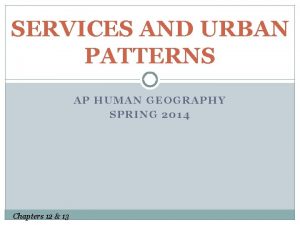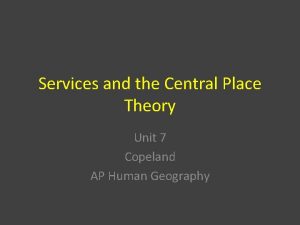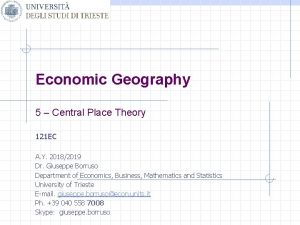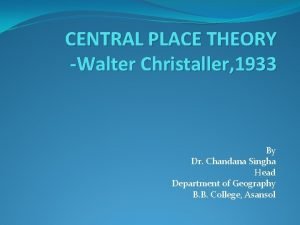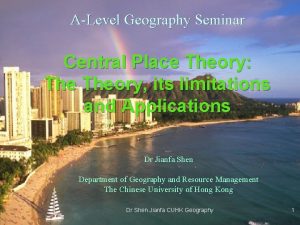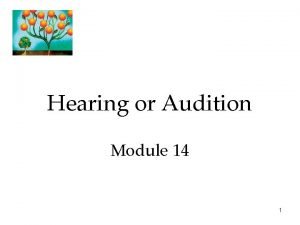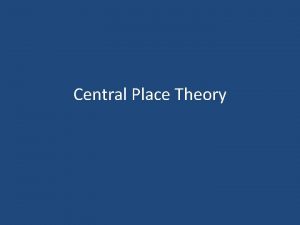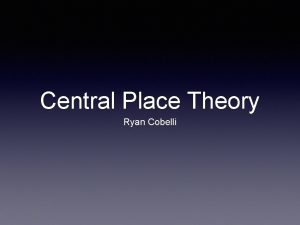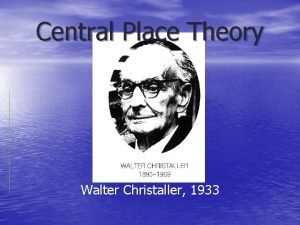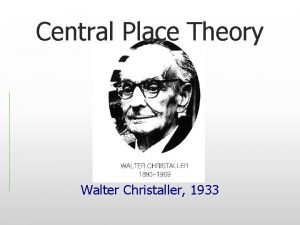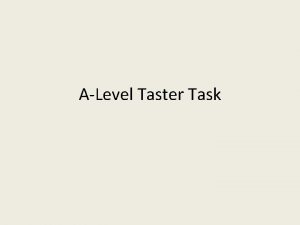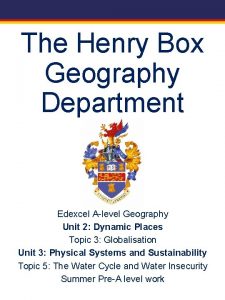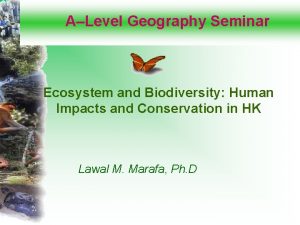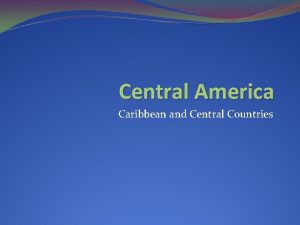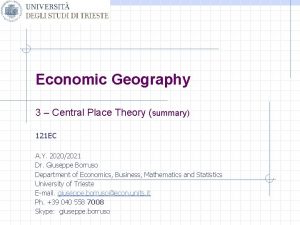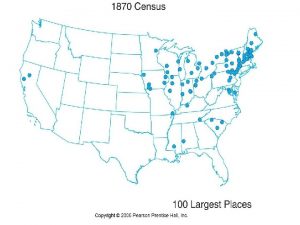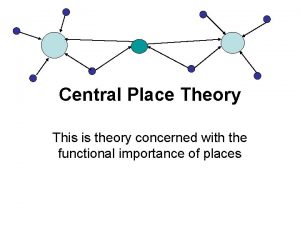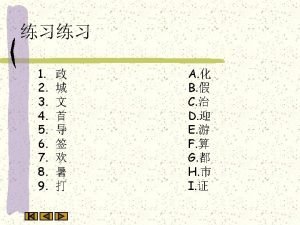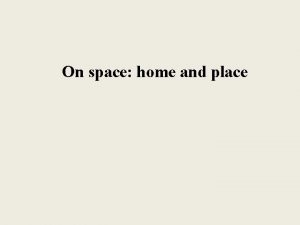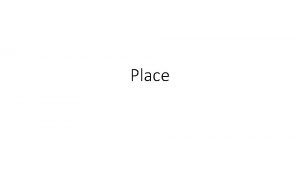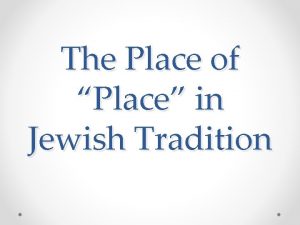ALevel Geography Seminar Central Place Theory Theory its






























- Slides: 30

A-Level Geography Seminar Central Place Theory: Theory, its limitations and Applications Dr Jianfa Shen Department of Geography and Resource Management The Chinese University of Hong Kong Dr Shen Jianfa CUHK Geography 1

Content 1. Concept of urban systems 2. The central place theory 3. Limitations 4. Applications Dr Shen Jianfa CUHK Geography 2

Urban system in Guangdong (54 cities by total population in 1998) Dr Shen Jianfa CUHK Geography 3

Concept of settlement * Settlement: forms of human habitation 2 Village 2 Town 2 City * Criteria 2 Size of population and built-up area, population density 2 Employment in secondary and tertiary sectors Dr Shen Jianfa CUHK Geography 4

Concept of urban systems * Systems of cities: urban systems * The law of the primate city * The rank-size rule * The central place theory Dr Shen Jianfa CUHK Geography 5

Central place theory: Basic concepts * * Developed by Walter Christaller in 1933 “Central Places in southern Germany”. Germany It is a deductive theory to explain the number, location, size, spacing and functions of settlements in terms of the services they performed for surrounding hinterlands. Central place: a service center, a settlement providing a range of goods and services to the surrounding areas. Centrality: the functions or services provided by central place. 2 The higher the centrality of a central place is, the more the variety of services and the higher the order of services it provides. * Hinterlands: the market areas covered by the services of central places that may include smaller central places. 2 The higher the centrality of a central place is, the larger the hinterland. Dr Shen Jianfa CUHK Geography 6

Assumption of idealized landscape * * An uniform transportation surface, the relative accessibility between any two points is a direct function of their distance. Population is evenly distributed. The goods and services are only provided in central places Each point has an equal chance of receiving a central place Dr Shen Jianfa CUHK Geography 7

Service ranges * Upper limit of the range: * 2 the maximum distance (r) a consumer will travel to a center to obtain goods, the maximum area to be served from a center will be a circular region of radius r. Lower limit of the range: 2 the minimum radius (r’) of a circular service area with sufficient population (threshold population) to generate sufficient demands to make the central place economically viable to provide the service. Example: Key maker services Dr Shen Jianfa CUHK Geography 8

Service ranges * Lower-order service 2 Smaller upper limit and lower limit 2 Smaller market area 2 Low-order center * Higher-order service 2 Larger upper limit and lower limit 2 Larger market area 2 High-order center * The size of market area will be between the lower and upper limits Dr Shen Jianfa CUHK Geography 9

System based on the marketing principle * Marketing principle : 2 a. There should be a minimum number of central places of all sizes so that trade profits could be maximized; 2 b. The whole population of the area should be supplied with all goods and services. Dr Shen Jianfa CUHK Geography 10

Market areas: Circle or square? Dr Shen Jianfa CUHK Geography 11

Market areas: Hexagon? Dr Shen Jianfa CUHK Geography 12

Deriving the highest-order central places The upper limit of the highest order services is used to obtain the area for central places ranked ‘B’ to meet marketing principle a ; * Each central place serves a circular area with radius ‘r’ and the distance between any two central places is 2 r; but some areas are not served; * To meet marketing principle b, a modified structure of overlapping circles is necessary. Assume consumers go to the nearest central place, exclusive regular hexagonal areas are obtained as the service areas for B centers. * Dr Shen Jianfa CUHK Geography 13

Deriving the lower-order central places For goods and services with a smaller upper limit of range (e), some areas cannot be served by B centers, thus lower-order K centers are needed; * To be most competitive with B centers, these K centers will be located in the center of areas not served with maximum distance to all B centers; * These K centers are also the corners of the hexagonal areas of B centers; * Each B center service area will cover three K center service areas, this was called k=3 framework. * Dr Shen Jianfa CUHK Geography 14

Central Place Theory K=3 Marketing principle K=7 Administration principle K=4 Transport principle Dr Shen Jianfa CUHK Geography 15

System based on the transportation principle * Transportation principle: 2 Lower-order centers will develop along the transportation lines linking the higher-order centers. 2 K centers will locate in the middle of the transportation link between any two B centers; 2 Each B center service area covers four service areas of K centers, this was called k=4 framework. Dr Shen Jianfa CUHK Geography 16

System based on the administration principle * Administration principle: 2 The service areas of K centers should be COMPLETELY contained by a service area of B center; 2 Each B center service area covers 7 service areas of K centers, this is called k=7 framework. Dr Shen Jianfa CUHK Geography 17

Contributions of central place theory * It defines the ideal pattern of central places and explains why an urban hierarchy may exist in the reality. 2 A small number of high-order centers serve large hinterland; 2 Many low-order centers serve small hinterland. * It provides a basis for planning the size and spacing of centers in newly-developing areas. Dr Shen Jianfa CUHK Geography 18

Limitations An uniform transportation surface, the relative accessibility between any two points is a direct function of their distance. 2 In reality, there are transport routes and natural barriers like rivers and coastal lines. Accessibility is different over space * Population is evenly distributed. 2 In reality, population density is uneven. Other than services, population is also related to manufacturing activities. * Dr Shen Jianfa CUHK Geography 19

Limitations * Each point has an equal chance of receiving a central place 2 Physical conditions, historical legacy and government policy may favour particular locations. 2 Above factors will distort the ideal size, location and spacing of central places. * Highest-order center offers all the low-order services 2 Some low-order service may not be offered in highest-order center * The centers of the same order will offer same range of services 2 The services offered by the centers of the same order may be different Dr Shen Jianfa CUHK Geography 20

Limitations * Discrete distribution of the size of central places 2 Number of central places by order in K=3 system 2 1, 2, 6, 18, 54, 162, 486, … * Real urban system is the result of SPACIAL PROCESSES and the Physical, Historical conditions and Policies. Dr Shen Jianfa CUHK Geography 21

Applications * The impact of increased population density or increased income of population 2 Consumer expenditure will increase 2 Further high-order services will be required 2 Increase the potential number of levels of hierarchy 2 Increase the degree of functional specialization of the highest-order center Dr Shen Jianfa CUHK Geography 22

Applications * The impact of improved transportation on central place system 2 Population mobility increased 2 People are willing to travel longer to obtain services 2 Market area of a central place will expand 2 Restructuring of central places, some have to be closed. Dr Shen Jianfa CUHK Geography 23

Case 1: Settlement system in Zhejiang, China Dr Shen Jianfa CUHK Geography 24

Case 2: Urban system in Hong Kong Dr Shen Jianfa CUHK Geography 25

Shopping center planning in HK * Metropolitan Centers 2 Catchment population: Whole HK and tourists 2 Range of goods: consumer durable goods, many banks and commercial services, cinemas, theatres, restaurants, entertainment and social facilities. 2 Examples: located at Central, Tsim Sha Tsui and Causeway Bay Dr Shen Jianfa CUHK Geography 26

Shopping center planning in HK * Regional Centers 2 Catchment population: 250, 000 to 1, 000 2 Range of goods: department stores/supermarkets, many ancillary services, i. e. banks, restaurants, cinemas, theatres and other social facilities 2 Examples: new town centers. Typical centers may range from 50, 000 to 250, 000 sq. m. Dr Shen Jianfa CUHK Geography 27

Shopping center planning in HK * District Centers 2 Catchment population: 50, 000 to 250, 000 2 Range of goods: limited entertainment and social facilities, but significant concentrations of retail facilities and restaurants 2 Examples: medium-scale shopping centers of town -wide or district significance, Wan Chai in the urban area and Kam Tin in NT. Typical centers may range from 10, 000 to 50, 000 sq. m. Dr Shen Jianfa CUHK Geography 28

Shopping center planning in HK *Local Centers 2 Catchment population: less than 50, 000 2 Range of goods: small-scale concentrations of shops for local retail services and restaurants, such as in Fung Tak Estate and Tai Yuen Estate. Local centers are less than 10, 000 sq. m. * Source: HK Planning Standards and Guidelines, http: //www. info. gov. hk/planning/tech_doc/hkpsg/index_e. htm Dr Shen Jianfa CUHK Geography 29

Thank you ! Dr Shen Jianfa CUHK Geography 30
 Central place theory definition
Central place theory definition Edexcel alevel history
Edexcel alevel history Aqa alevel data sheet
Aqa alevel data sheet Drama alevel
Drama alevel Aqa alevel psychology
Aqa alevel psychology Linear settlement ap human geography
Linear settlement ap human geography Place theory
Place theory August lösch
August lösch Christaller central place theory
Christaller central place theory Christaller's central place theory
Christaller's central place theory What are some limitations of central place theory
What are some limitations of central place theory Millions billions trillions chart
Millions billions trillions chart A repeating disturbance that transfers energy
A repeating disturbance that transfers energy A disturbance that transfers energy from place to place
A disturbance that transfers energy from place to place Mapographer definition
Mapographer definition 5 themes of geography orlando florida
5 themes of geography orlando florida Difference between formal and functional region
Difference between formal and functional region Geographers look at the world
Geographers look at the world Where is the setting?
Where is the setting? Frq format ap human geography
Frq format ap human geography 5 themes of geography ap human geography
5 themes of geography ap human geography Ap human geography political geography test
Ap human geography political geography test A central message or insight
A central message or insight Key quotes in the emigree
Key quotes in the emigree When a train increases its velocity its momentum
When a train increases its velocity its momentum Sunny cloudy windy rainy
Sunny cloudy windy rainy If its square its a sonnet
If its square its a sonnet Its halloween its halloween the moon is full and bright
Its halloween its halloween the moon is full and bright Its not easy but its worth it
Its not easy but its worth it Place theory
Place theory Bulk reducing industry ap human geography
Bulk reducing industry ap human geography





